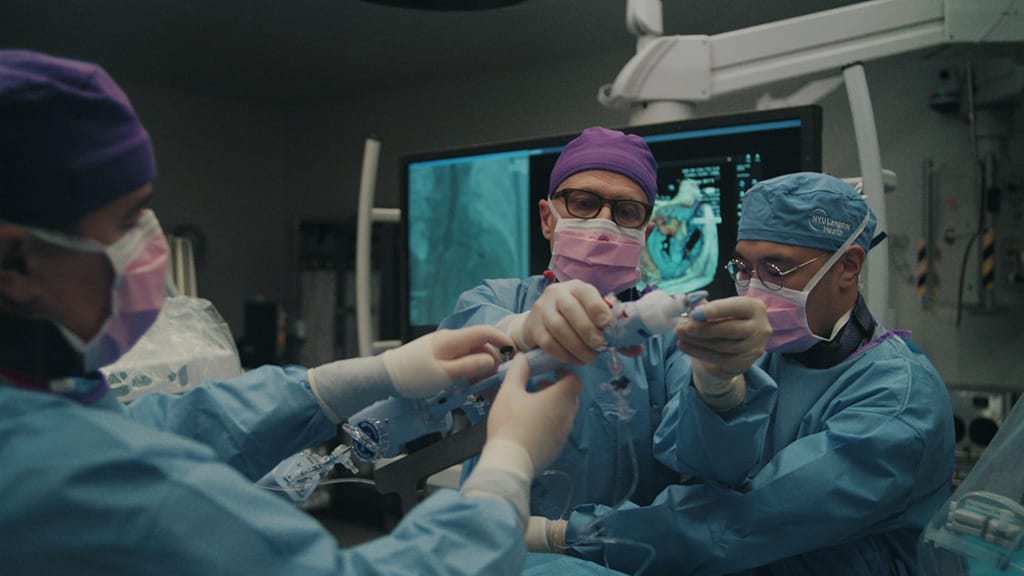To say the New York metro area is a busy place is putting it lightly.
No matter what your industry is, a lot of action goes on in the five boroughs and surrounding three states.
Healthcare is stranger to this dynamic, with millions of patients seeking premier care and reliable messaging from some of the most respected and competitive organizations around.
So when it comes to navigating challenges related to communicating about healthcare, Debbie Cohn, VP of marketing and digital communications at NYU Langone, says disruption is a necessity.
“We are in the most cluttered/congested ad market in the world in New York and we’re also in the most crowded healthcare space,” she notes.
The organization’s latest campaign attempts to cut through that clutter with three films: Heart, Home and Time.
The short films highlight different aspects of the patient care provided by NYU Langone. The goal of all the spots is to pull off a marriage of facts with emotions for patients all across the city.
Patient stories fuel film
Deloitte Digital, a 2023 MM+M Agency 100 honoree, worked with the Manhattan-based health system on the effort, which group creative director Aaron Sidorov says is based around a simple truth and pairs “humanity with the data.”
“So let’s just take Time, for instance. It’s ultimately about having the highest success rates for lung transplants and getting patients off the waitlist five times faster,” he says. “Another one of the films [Home] is about taking your baby in for heart surgery and getting your baby back home — healthy — four weeks sooner. The idea of weeks for a newborn is everything.”
As with many effective medical marketing campaigns, the films emerged out of extensive research — in this case much of it consisted of listening to some of the 47,000 employees of NYU Langone.
Sidorov shares that the agency spent months at NYU Langone interviewing doctors, clinicians and staff members about everything they do, how they run their teams and the innovations they’ve pioneered. The exercise was conducted in part to understand not just the outcomes the organization delivers, but also what makes them tick as individuals or a department.
“From that we were able to uncover these very unique, simple insights that ultimately inspired the campaign that you see,” he says.
The contributions by employees extended beyond their participation in interviews, as a few employees appeared in the spots. The ads were all shot on location at NYU Langone facilities — which in itself presented a formidable challenge for hospital staff.
“While there were 25 people cast in these three films, there were 250 NYU Langone team members involved in the production because it’s always going to be patient first,” Cohn explains. “We’re going to figure out this production without disrupting any patient experience whether that means people working longer hours and creating new spaces to work in.”

Busy production site
This would be an obstacle in its own right in any city, but producing this in New York made it even more difficult.
“You’re talking about not only an active hospital, but an active hospital right in the middle of the busiest city in the world — with doctors who are on call at all hours,” Sidorov adds. “It is a fascinating thing to have been part of; to watch a hospital in the middle of New York City provide this type of access to its people.”
The campaign’s supporting content will run across social, OOH, print and digital channels including in Times Square, the Long Island Railroad and Link NYCs.
The Time spot also aired regionally in Palm Beach, highlighting that the healthcare system’s reach extends to South Florida (as well as Philadelphia, Boston, and other markets, sometimes depending on specialty). All three commercials will be aired throughout the spring.
For Cohn, the films’ pairing of data and emotion is key to getting consumers to focus on statistics like death rates and see through a common misconception that the doctor you select is going to unilaterally determine your outcome.
“In reality, it’s the health system you use that’s going to impact your survival rate,” she notes.
Additionally, she describes this as part of an ongoing development when it comes to NYU Langone messaging, noting that the organization sought to team its expertise and emotion for these films.
“We wanted to hit a little harder with the data points of why that health system matters. People don’t want to think about mortality rates unless they have to and so we leaned in on the data visualization, but also doubled down on the empathy as well,” she says.







